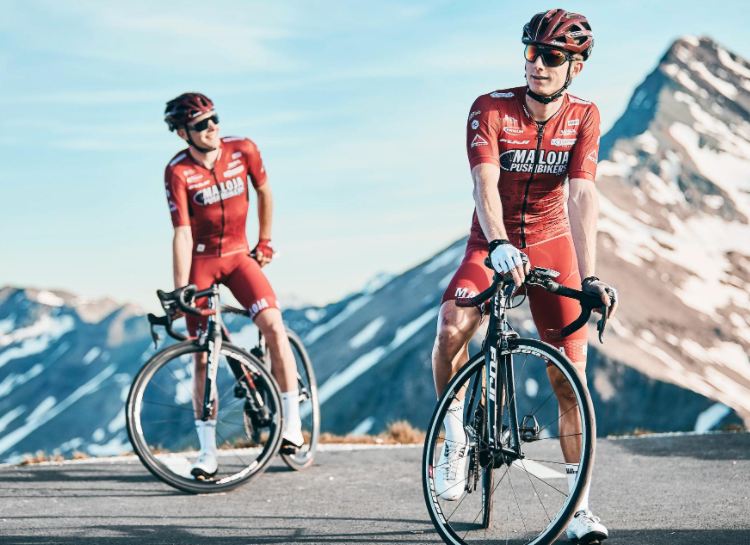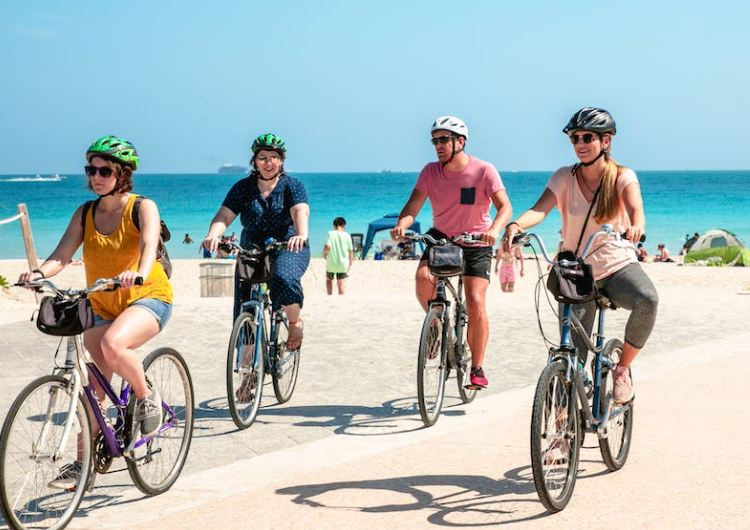As cycling has been steadily growing in popularity over recent years, more and more people are looking for ways to get into the sport and to get fit. The 6-week cycling Training Program for Beginners is designed to help newcomers build a solid foundation so that they can have an enjoyable and safe experience as they become accustomed to their new activity.
This program is great for those looking to establish the basics, learn proper form, build endurance and accuracy over time, as well as burn some calories — with some participants having reported up to 500 calories burned per ride!
Table of Contents:
- Part 1: Benefits of a Cycling Training Program for Beginners
- Part 2: Understanding the Basics of Cycling
- Part 3: Detailed 6-Week Cycling Training Program
- Part 4: Nutrition and Hydration
- Part 5: Post-Cycling Recovery
- Part 6: Extra Tips for Cycling Beginners
Part 1: Benefits of a Cycling Training Program for Beginners
The benefits of the cycling training program go beyond just learning how to ride a bike. Regular practice improves flexibility and balance, strengthens joints, muscles, and your heart, and helps maintain a healthy weight. On top of all that, it can be an incredibly fun experience — who doesn’t love feeling the wind scream as you zoom past?
-
Develop proper riding form and techniques
Learning to ride correctly is extremely important. An incorrect posture or pedaling technique can lead to sore ankles, wrists, and backs while riding. This program will make sure you learn proper cycling form right from the start!
-
Increases cardiovascular endurance
Every session can have an impact on your overall stamina levels so that cycling becomes more enjoyable in the long run. Additionally, biking regularly reduces stress hormone levels.
-
Increases leg strength and muscle mass
With every pedal push, your legs become stronger and offer better support during rides — not forgetting about improved aesthetics along the way!
Part 2: Understanding the Basics of Cycling
Learning how to ride a bike is one of those life skills that’s commonly taught at a young age and many people take its simplicity for granted. During this phase of our training, we’ll be focusing on exploring and understanding the basics as well as figuring out the outlook ahead.
Essential pieces of equipment: As with any other activity, biking has its own set of tools and items — it’s important to get familiar with what’s needed to have an enjoyable experience on two wheels!
-
Bike
Firstly, make sure your bike is properly adjusted! Uneven handlebars or pedals can become uncomfortable over long rides while having air pressure checked regularly can prevent punctures. Also, consider pedal reflectors or indicators if you will be cycling at night or dusk.
-
Helmet and Protective Gear
Wearing a helmet is one of the best things to keep in mind – especially when it comes to safety! Moreover, wear ankle and knee pads for extra protection in case you fall, and glasses so wind and debris won’t hit your eyes while riding.
-
Clothing and Accessories
For longer climbs try lightweight garments made with breathable fabric for moisture-wicking capabilities… When doing shorter rides comfort should never be compromised. Some riders find it comfortable to wear gloves while others like using bells/horns to signal their presence during turns. Ultimately the choice comes down to personal preference!
Part 3: Detailed 6-Week Cycling Training Program
This 6-week program consists of three phases: building the foundation, refining skills and increasing distance, and full-blown weekly rides. The weeks are divided into 4 days with an optional rest day to give your body some recovery in between.
-
Building the foundation (weeks 1 and 2)
Start by getting familiar with your bike, understand how the brakes work, practice balance while motionless, and if needed start pedaling around a driveway or park.
As movements become smooth begin gap analysis — identify comfort levels and address any problem areas that may arise. Aim for up to 20 minutes of shift-break pedaling here without using gears as this will help you master correct posture before advancing further on.
-
Refining skills and increasing distance (weeks 3 and 4)
Work on technique until riding with a straight back becomes second nature, use gears according to terrain angles/inclines to go faster but sustain energy for longer lengths. Focus on square cycling. Each session should last around 40 minutes.
So lower lung capacity will not pose a limitation when progressing. Compete against yourself while tracking distance rather than speed — beginners might find aiming for 5+ km sessions effective — then ride two or more days consecutively to check how gradual muscle improvement impacts comfort levels along different routes!
-
Full-blown weekly rides (weeks 5 and 6)
From here onwards we’ll continue increasing the total time spent biking by adding seconds every day until we achieve usage of all gears/terrains while mastering hill climbing abilities through style coaching!
Significantly longer sessions can be expected from here, recording 10+ km in one take should offer ample endurance training opportunities also allowing you to observe changes in aerobic capacities — soon enough you’ll have no trouble taking lengthy trips for sightseeing as well! Just remember: listen closely to your body at all times and never forget safety guidelines!
Below you can take a complete plan, but feel free to vary volume according to your fitness background and health condition.
-
Program Example:

Week 1 and 2: Building the Foundation
– Day 1: Short ride (10-15 minutes), focusing on balance and getting used to the bike.
– Day 2: Rest day.
– Day 3: Increase ride time to 15-20 minutes, practicing pedaling without gears.
– Day 4: Rest day.
– Day 5: 20-minute ride, focusing on correct posture and comfort.
– Day 6: Rest or optional light ride.
– Day 7: 20-25 minutes ride, aim for steady, consistent pedaling.
Week 3 and 4: Refining Skills and Increasing Distance
– Day 1: 30-minute ride, start experimenting with gears on different terrains.
– Day 2: Rest day.
– Day 3: 35-40 minute ride, focusing on maintaining a straight back.
– Day 4: Rest day.
– Day 5: 40-45 minute ride. Aim for 5+ km if possible.
– Day 6: Rest or optional light ride.
– Day 7: 45-50 minute ride, start to test different speeds with your gears, and maintain a steady rhythm.
Week 5 and 6: Full-blown weekly rides
– Day 1: 50-60 minute ride, start to use all gears. Try to tackle a hill or two.
– Day 2: Rest day.
– Day 3: 60-70 minute ride. Pay close attention to how different terrains alter the difficulty.
– Day 4: Rest day.
– Day 5: 70-80 minute ride or aim for a 10 km trip.
– Day 6: Rest or optional light ride.
– Day 7: 80-90 minute ride or longer. Try to observe changes in your aerobic capacity and strength.
Part 4: Nutrition and Hydration
Nutrition and hydration are integral parts of any training program — cycling is no exception! During intense training, the body’s systems need help in recovering faster after exertion. What you eat before, during, and after your rides can make a significant impact on your overall performance and endurance levels.
-
Before The Ride
Eating around an hour or two before the ride offers all the carbs/sugars needed to sustain energy levels throughout the session. Whole wheat toast with almond butter or banana smoothies topped with waffles/granola are some great options for a pre-ride snack while protein bars boost stamina when competing against time. Make sure not to overdo it — go easy on fluids if possible!
-
During The Ride
If pedaling for more than 1 hour then drinks and snacks should be brought for refueling every 20 – 30 minutes. Try electrolyte drinks containing sodium and potassium that will speed up water uptake into cells as well as food items such as dates that provide powerful sources of energy instantaneously — just don’t forget about regular sips from water bottles throughout each ride.
-
After The Ride
No matter how long you stay out riding, always refuel with healthy snacks after exercise to replenish the sugars and electrolytes lost during activity. Smoothies mixed with fruits and Greek yogurt provide the best combination of all macronutrients while quick bites such as cereal bars offer added convenience — also try drinking at least around 500 ml of water following your trip for better recovery! All in all bear in mind this triangle of nutrition so you have an enjoyable experience on two wheels today and many days ahead!
Part 5: Post-Cycling Recovery
Just as important as the ride itself is post-cycling recovery! Replenishing nutrients, stretching and breaking muscle fibers to allow for muscle growth and soothing sore muscles are some of the steps beginners should take to enjoy healthy progress throughout their cycling endeavors. Here’s a list of things that can help aid recovery:
-
Post-ride cooling down
Giving your body the chance to slowly get back into resting pace after an intense session can bring about benefits such as improving your overall flexibility. Try exercises like walking or pedaling slowly with low resistance to quickly reach the cool-down process without putting pain in bones or joints.
-
Stretching
After getting off the bike go ahead and extend your legs, calves, and spine to release any pressure points endured during riding time — gradually increase minutes per session here and establish a static/dynamic routine as you gain more experience!
-
Massaging/Ice Bathing
Soft tissue massages are popular among athletes due to their ability to reduce inflammation and break up knots caused by inadequate form. Cold showers also provide relief for those dealing with delicate areas while invigorating feelings when hopping into a hot bath at the end of long days!
-
Eating Regimens
Finish exercise cycles by ingesting carbohydrates for energy replenishment, drinking plenty of water, and focusing on whole foods whenever possible — fresh fruits and vegetables should offer ample nutrition without being hard on digestion systems. Protein shakes and protein bars mixed with milk make natural supplements available if unable to find solid food sources at short notice.
Part 6: Extra Tips for Cycling Beginners
-
Practice As Much As Possible
While this might sound like a cliché it will make the experience so much more enjoyable with time. Start off pedaling in contained environments such as driveways to identify weak areas and progress from there at your own pace — soon enough your favorite routes will become almost second nature!
-
Make Use Of Technology
There are countless free retuning applications available to download onto devices, these programs make tracking distances, caloric burn, and even saddle/handlebar measurements possible!
-
Have Fun!
Enjoy every moment of being out and exploring new routes, don’t sweat over tiny obstacles, and always remember safety comes first — keep in mind regulations established in every country can differ rapidly regarding bicycles…sometimes helmets aren’t mandatory!
Over time dial up speed without risking injury — think of how far you’ve come which hopefully looks something like this: Start your journey slow BUT steady till you get to the intermediate stage where results start peaking. Most importantly never forget having an incredible human-powered machine at your disposal means coming into contact with nature more often than usual.
Conclusion
Getting into cycling can be daunting for those just starting, however, as you adjust to the mental and physical aspects of biking slowly but surely the journey becomes more enjoyable. It is important to remember that each person should find out what works best for them so they have a safe and rewarding experience on two wheels.
Whether you are looking to increase your endurance levels, burn some calories, or aim for greater speed and distance progressions — consider using this Cycling Training Program for Beginners as an example base and build from there until long rides are second nature!
Don’t forget essential safety measures: always wear a helmet and use reflective equipment and necessary gear before riding in uncontrolled environments. These acts will ensure riders stay healthy while having incredible fun experiences either alone or with others! From understanding basic biker tips/tricks all the way into nutrition regimes, this article covers all cycling beginners need to know before hopping into their saddle!

 By myulikeadmin
By myulikeadmin



